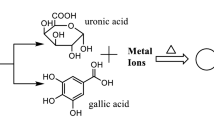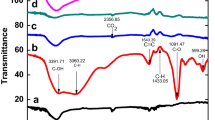Abstract
Ellagic acid is a biologically active polyphenol found in numerous fruits and vegetables. However, not many papers dealing with the electrochemical properties and protolytic equilibria of ellagic acid have been published so far. The electro-oxidation mechanism of ellagic acid was studied in methanol aqueous media (1:1, v/v) within the pH range of 1.5–9.0, t = 25 ± 1 °C, using cyclic voltammetry on a glassy carbon electrode, and by semiempirical calculations. Results show that oxidation of ellagic acid is a pH-dependent, two-step quasireversible process. The slope of peak 1 indicates the exchange of the same number of electrons and protons within the whole studied pH range; the slope of peak 2 changes with the increase of pH, and three different regions are visible. As protolytic equilibria studies revealed that ellagic acid acts as a diprotic acid in the studied conditions (acidity constants were potentiometrically determined as pK a1 = 5.42 ± 0.01 and pK a2 = 6.76 ± 0.01), it is obvious that the electro-oxidation occurs at the hydroxyl group subjected to dissociation. The three different regions are therefore recognized as regions with different dominating species: unionized molecule (H4A), monoanion (H3A−), and dianion (H2A2−). UV/Vis spectral changes confirmed the proposed equilibria. Heat of formation and electron densities calculated at semiempirical level were used to propose the hydrogen and electron abstraction sites. According to the obtained results, a new mechanism of ellagic acid electro-oxidation is proposed.
Graphical abstract










Similar content being viewed by others
References
Zafrilla P, Ferreres F, Tomás-Barberán A (2001) J Agric Food Chem 49:3651
Da Silva Pinto M, Lajolo FM, Genovese MI (2008) Food Chem 107:1629
Lee JH, Talcott ST (2004) J Agric Food Chem 52:361
Williner MR, Pirovani ME, Güemes DR (2003) J Sci Food Agric 83:842
Häkkinen S, Heinonen M, Kärenlampi S, Mykkänen H, Ruuskanen J, Törrönen R (1999) Food Res Int 32:345
Loarca-Pina G, Kuzmicky PA, de Mejía EG, Kado NY, Hsieh DPH (1996) Mutat Res. Environ Mutagen Relat Subj 360:15
Priyadarsini KI, Khopde SM, Kumar SS, Mohan H (2002) J Agric Food Chem 50:2200
Rogerio AP, Fontanari C, Borducchi É, Keller AC, Russo M, Soares EG, Albuquerque DA, Faccioli LH (2008) Eur J Pharmacol 580:262
Malini P, Kanchana G, Rajadurai M (2011) Asian J Pharm Clin Res 4:124
Soh PN, Witkowski B, Olagnier D, Nicolau ML, Garcia-Alvarez MC, Berry A, Benoit-Vical F (2009) Antimicrob Agents Chemother 53:1100
Pari L, Sivasankari R (2008) Fundam Clin Pharmacol 22:395
Kannan MM, Quine SD (2011) Eur J Pharmacol 659:45
Edderkaoui M, Odinokova I, Ohno I, Gukovsky I, Go VLW, Pandol SJ, Gukovskaya AS (2008) World J Gastroenterol 14:3672
Khanduja KL, Gandhi RK, Pathania V, Syal N (1999) Food Chem Toxicol 37:313
Umesalma S, Sudhandiran G (2011) Eur J Pharmacol 660:249
Yüce A, Ateşşahin A, Çeribaşi AO (2008) Basic Clin Pharmacol Toxicol 103:186
Wright JS, Johnson ER, DiLabio GA (2001) J Am Chem Soc 123:1173
Vafiadis AP, Bakalbassis EG (2005) Chem Phys 316:195
Musialik M, Litwinienko G (2005) Org Lett 7:4951
Zhang J, Xiong Y, Peng B, Gao H, Zhou Z (2011) Comp Theor Chem 963:148
Ghoreishi SM, Behpour M, Khayatkashani M, Motaghedifard MH (2011) Dig J Nanomater Bios 6:625
Ghoreishi SM, Behpour M, Khayatkashani M, Motaghedifard MH (2011) Anal Methods 3:636
Thakur K, Pitre KS (2008) J Chin Chem Soc 55:143
Cuartero M, Ortuño JA, Truchado P, García MS, Tomás-Barberán FA, Albero MI (2011) Food Chem 128:549
Komorsky-Lovrić Š, Novak I (2011) J Food Sci 76:C916
Komorsky-Lovrić Š, Novak I (2011) Int J Electrochem Sci 6:4638
Bala I, Bhardwaj V, Hariharan S, Ravi Kumar MNV (2006) J Pharm Biomed Anal 40:206
Hasegawa M, Terauchi M, Kikuchi Y, Nakao A, Okubo J, Yoshinaga T, Hiratsuka H, Kobayashi M, Hoshi T (2003) Monatsh Chem 134:811
Muñoz-Muñoz JL, Garcia-Molina F, Garcia-Molina M, Tudela J, García-Cánovas F, Rodriguez-Lopez JN (2009) IUBMB Life 61:171
Queimada AJ, Mota FL, Pinho SP, Macedo EA (2009) J Phys Chem B 113:3469
Albert A, Serjeant EP (1971) The determination of ionization constants, 2nd edn. Chapman and Hall, London
Gans P, Sabatini A, Vacca A (1996) Talanta 43:1739
Stewart JJP (1990) J Comput Aid Mol Des 4:1
Stewart JJP (2007) MOPAC 2007, Stewart computational chemistry, Colorado Springs, CO. http://OpenMOPAC.net Accessed 28 March 2012
Irving HM, Miles MG, Pettit LD (1967) Anal Chim Acta 38:475
Acknowledgments
The Ministry of Education and Science of Serbia supports this work (grants 172030 and 172035). The reported computational work makes use of results produced by the High-Performance Computing Infrastructure for South East Europe’s Research Communities (HP-SEE), a project cofunded by the European Commission (under contract number 261499) through the Seventh Framework Programme HP-SEE (http://www.hp-see.eu/).
Author information
Authors and Affiliations
Corresponding author
Rights and permissions
About this article
Cite this article
Simić, A.Z., Verbić, T.Ž., Sentić, M.N. et al. Study of ellagic acid electro-oxidation mechanism. Monatsh Chem 144, 121–128 (2013). https://doi.org/10.1007/s00706-012-0856-8
Received:
Accepted:
Published:
Issue Date:
DOI: https://doi.org/10.1007/s00706-012-0856-8




